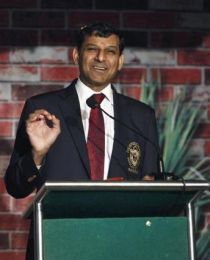 In its first bi-monthly monetary policy statement for 2014-15, scheduled for April 1, the Reserve Bank of India might give an estimate of interest rates only for the period up to the next policy review.
In its first bi-monthly monetary policy statement for 2014-15, scheduled for April 1, the Reserve Bank of India might give an estimate of interest rates only for the period up to the next policy review.
Beyond that, the rates will depend on the outlook for the monsoon, as well as the elections.
While the monsoon will have a direct impact on food prices, after the elections, a new government might announce an expansionary Budget, which could put pressure on inflation.
Voting for the 2014 general elections will begin in April and it is expected Budget 2014-15 will be presented in June. By then, the outlook for the monsoon, too, will be clear.
The Urjit Patel committee, set up to strengthen the monetary policy framework, had recommended bi-monthly monetary policy reviews by the central bank.
As suggested by the committee, RBI is focusing more on Consume Price Index-based inflation, rather than wholesale inflation.
In February, CPI inflation fell to a 25-month-low of 8.1 per cent compared to a year earlier.
Shubhada Rao, chief economist, YES Bank, said, “The guidance will be only for the next policy review, and that will depend on the trajectory of CPI inflation.
"Besides, there are two important factors---the outlook for the monsoon and the impact on food inflation.
"Also, a new government will be formed after the elections.”
A Prasanna, chief economist, ICICI Securities Primary Dealership, said, “The guidance will say if CPI inflation moves according to the trajectory, the rates will stay at these levels.
"I do not think RBI will be able to give guidance for a long period.”
In January, RBI had raised the repo rate by 25 basis points to eight per cent and pointed to a 'glide path' towards lowering CPI inflation to less than eight per cent by January 2015 and six per cent a year later.
The Urjit Patel committee had said owing to the high CPI inflation, supply constraints and weak output, inflation should be reduced to less than eight per cent through 12 months and to less than six per cent through 24 months.
Beyond that, four per cent inflation (+/- two per cent) should be targeted, the panel had said.
Indranil Pan, chief economist, Kotak Mahindra Bank, said, “The inflation trajectory remains on track to soften to eight per cent by January 2015.
"However, core inflation has remained sticky, implying the chances of demand-led inflationary pressures are still high. Our output gap estimate hints even with the anticipated marginal pick-up in growth, inflationary pressures could be significant.
"RBI will likely be mindful of this and, therefore, we expect it to maintain status quo on rates at its next policy meeting on April 1, with the communication remaining balanced.
"Our base-case scenario remains an extended pause for most of 2014.”
At its policy review in January, RBI had said it expected a modest recovery in economic growth in 2014-15. However, it cautioned inflation risks might remain.
“On current reckoning, growth in 2013-14 is likely to fall somewhat short of the Reserve Bank’s earlier projection of five per cent.
"However, a moderate recovery is likely to shape next year, with support from rural demand, a pick-up in exports and some turnaround in investment demand. For 2014-15, growth is likely to be in the range of five-six per cent,” the central bank had said.
Image: RBI Governor Raghuram Rajan











 © 2025
© 2025